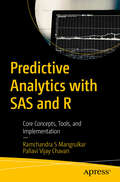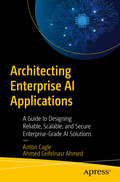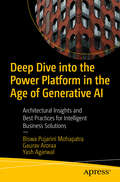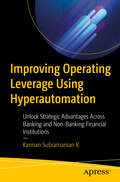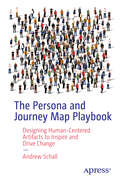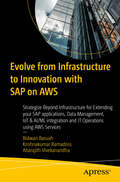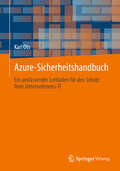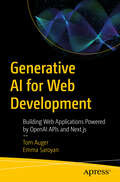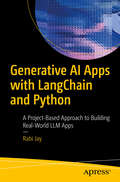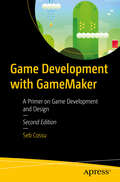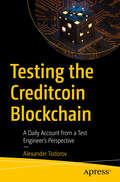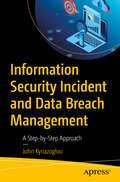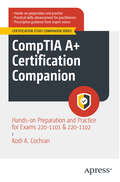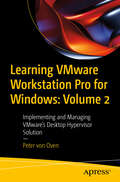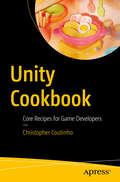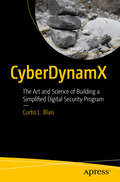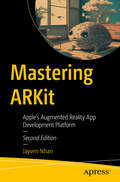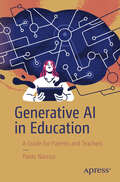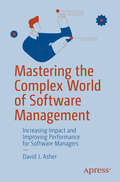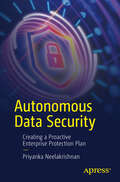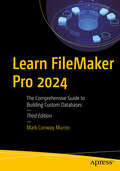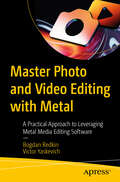- Table View
- List View
Data Science Solutions on Azure: The Rise of Generative AI and Applied AI
by Julian Soh Priyanshi SinghThis revamped and updated book focuses on the latest in AI technology—Generative AI. It builds on the first edition by moving away from traditional data science into the area of applied AI using the latest breakthroughs in Generative AI. Based on real-world projects, this edition takes a deep look into new concepts and approaches such as Prompt Engineering, testing and grounding of Large Language Models, fine tuning, and implementing new solution architectures such as Retrieval Augmented Generation (RAG). You will learn about new embedded AI technologies in Search, such as Semantic and Vector Search. Written with a view on how to implement Generative AI in software, this book contains examples and sample code. In addition to traditional Data Science experimentation in Azure Machine Learning (AML) that was covered in the first edition, the authors cover new tools such as Azure AI Studio, specifically for testing and experimentation with Generative AI models. What's New in this Book Provides new concepts, tools, and technologies such as Large and Small Language Models, Semantic Kernel, and Automatic Function Calling Takes a deeper dive into using Azure AI Studio for RAG and Prompt Engineering design Includes new and updated case studies for Azure OpenAI Teaches about Copilots, plugins, and agents What You'll Learn Get up to date on the important technical aspects of Large Language Models, based on Azure OpenAI as the reference platform Know about the different types of models: GPT3.5 Turbo, GPT4, GPT4o, Codex, DALL-E, and Small Language Models such as Phi-3 Develop new skills such as Prompt Engineering and fine tuning of Large/Small Language Models Understand and implement new architectures such as RAG and Automatic Function Calling Understand approaches for implementing Generative AI using LangChain and Semantic Kernel See how real-world projects help you identify great candidates for Applied AI projects, including Large/Small Language Models Who This Book Is For Software engineers and architects looking to deploy end-to-end Generative AI solutions on Azure with the latest tools and techniques.
AI Essentials Guide: Principles for Navigating the Next Tech Renaissance
by William HawkinsThis is a comprehensive exploration into the world of Artificial Intelligence, designed to bridge the gap between theoretical concepts and practical, real-world applications. This book unravels the mystique of AI, breaking down its components into understandable elements. From the early dawn of AI's inception to its current state of rapid evolution, we cover the essential building blocks necessary for leveraging AI in business, and personal development, and understanding its broader impacts on society. Through an engaging conversational format, readers are guided through the intricacies of AI, covering topics such as machine learning, AI governance,, data security, and the ethical challenges facing AI today. This book is an invaluable resource for those looking to understand the fundamentals of AI, its practical applications, and its significant implications for the future. After reading this book, you will be able to integrate AI into your business strategies and learn the intricacies of AI advancements. What You Will Learn: Key concepts and definitions within AI, including types of AI, machine learning, and neural networks and how they are utilized in AI apps like M365 Copilot Practical applications of AI for personal and business growth, focusing on the pillars of using AI to evolve these fronts effectively and sustainably How AI is transforming businesses and what organizational shifts must be made to realize the value Navigating the challenges and ethical considerations in AI to ensure informed and responsible usage Who This Book Is For: Professionals looking to integrate AI into their business strategies or organizations.
Design and Deploy IoT Network & Security with Microsoft Azure: Embrace Microsoft Azure for IoT Network Enhancement and Security Uplift
by Puthiyavan Udayakumar Dr. R AnandanUnlock the potential of IoT with Microsoft Azure through this comprehensive guide, designed to elevate your understanding and implementation of cutting-edge IoT network and security solutions. Whether you are a beginner or a seasoned professional, this book offers clear, actionable insights to help you master the intricacies of IoT with Azure. This book equips you with the expertise to design and deploy secure, efficient, and scalable IoT networks using Microsoft Azure. It is your key to becoming a proficient IoT architect and security specialist. What You Will Learn Know the fundamentals of IoT networks and security, including key concepts, terminologies, and the importance of securing IoT deployments Dive into Azure Edge Services to design and deploy edge solutions that bring computation and data storage closer to the data source, enhancing speed and efficiency Explore the architecture and deployment of Azure IoT networks to gain practical knowledge on setting up scalable, reliable, and secure IoT networks tailored to your needs Study best practices and strategies for securing your IoT environment and ensuring robust protection against emerging threats Monitor and manage your IoT solutions effectively via tools and techniques for maintaining optimal performance, diagnosing issues, and ensuring seamless operation of your IoT networks Who This Book Is For IoT network and security engineers, architects, and Azure IoT developers
Predictive Analytics with SAS and R: Core Concepts, Tools, and Implementation
by Pallavi Vijay Chavan Ramchandra S MangrulkarGain practical knowledge of application implementation using various programming approaches in predictive analytics. This book serves as a comprehensive guide for both beginners and professionals in the field of predictive analytics, offering core principles and practical insights without requiring an extensive mathematics or statistics background. The book starts with an introduction to analytics in decision making, protective analytics basics, and implementation in various industries. The book then takes you through types of regression, and simple linear regression in detail, followed by a demonstration of R Studio and SAS. Multiple Linear Regression is discussed next along with MLR model diagnostics. The book covers Multivariate Analysis and teaches you how to work with Principal Components Analysis, Factor Analysis, and much more. You also learn Time series Analysis with an understanding of Autoregressive Moving Average (ARMA) Models. After reading the book, you will be able to put predictive analytics principles into practice. What You Will Learn Understand modeling, estimating, and evaluating models for forecasting Implement Partial F-Test and Variable Selection Method Demonstrate each analysis model in R Studio and SAS Understand SLR and MLR Analysis models Who This Book Is For Students and professionals in the field of data analysis and intelligence applications
Architecting Enterprise AI Applications: A Guide to Designing Reliable, Scalable, and Secure Enterprise-Grade AI Solutions
by Anton Cagle Ahmed Mohamed AhmedThis book explores how to define, design, and maintain enterprise AI applications, exploring the impacts they will have on the teams who work with them. The book is structured into four parts. In Part 1: Defining Your AI Application, you are introduced to the dynamic interplay between human adaptability and AI specialization, the concept of meta systems, and the mechanics of prediction machines. In Part 2: Designing Your AI Application, the book delves into the anatomy of an AI application, unraveling the intricate relationships among data, machine learning, and reasoners. This section introduces the building blocks and enterprise architectural framework for designing multi-agent systems. Part 3: Maintaining Your AI Application takes a closer look at the ongoing life cycle of AI systems. You are guided through the crucial aspects of testing and test automation, providing a solid foundation for effective development practices. This section covers the critical tasks of security and information curation that ensure the long-term success of enterprise AI applications. The concluding section, Part 4: AI Enabled Teams, navigates the evolving landscape of collaborative efforts between humans and AI. It explores the impact of AI on remote work dynamics and introduces the new roles of the expert persona and the AI handler. This section concludes with a deep dive into the legal and ethical dimensions that AI-enabled teams must navigate. This book is a comprehensive guide that not only equips developers, architects, and product owners with the technical know-how of AI application development, but also delves into the broader implications for teams and society. What You Will Learn Understand the algorithms and processes that enable AI to make accurate predictions and enhance decision making Grasp the concept of metasystems and their role in the design phase of AI applications Know how data, machine learning, and reasoners drive the functionality and decision-making capabilities of AI applications Know the architectural components necessary for scalable and maintainable multi-agent AI applications Understand methodologies for testing AI applications, ensuring their robustness, accuracy, and reliability in real-world applications Understand the evolving dynamics of human-AI coordination facing teams in the new enterprise working environment Who This book Is For A diverse audience, primarily targeting enterprise architects, middle managers, tech leads, and team leads entrenched in the IT sector or possessing a tech-savvy background, including professionals such as digital marketers. Additionally, tech-savvy individual contributors—ranging from digital content creators and data analysts to administrators and programmers—stand to benefit significantly.
Deep Dive into the Power Platform in the Age of Generative AI: Architectural Insights and Best Practices for Intelligent Business Solutions
by Gaurav Aroraa Biswa Pujarini Mohapatra Yash AgarwalUnderstand the full potential of Microsoft Power Platform with this comprehensive guide, designed to provide you with the knowledge and tools needed to create intelligent business applications, automate workflows, and drive data-driven insights for business growth. Whether you're a novice or an experienced professional, this book offers a step-by-step approach to mastering the Power Platform. This book comes with an extensive array of essential concepts, architectural patterns and techniques. It will also guide you with practical insights to navigate the Power Platform effortlessly while integrating on Azure. Starting with exploring Power Apps for building enterprise applications, the book delves into Dataverse, Copilot Studio, AI Builder, managing platforms and Application life cycle management. You will then demonstrate testing strategy followed by a detailed examination of Dataverse and intelligent AI-powered Applications. Additionally, you will cover Power pages for external websites and AI-infused solutions. Each section is meticulously structured, offering step-by-step guidance, hands-on exercises, and real-world scenarios to reinforce learning. After reading the book, you will be able to optimize your utilization of the Power Platform for creating effective business solutions. What You Will Learn: Understand the core components and capabilities of Power Platform Explore how Power Platform integrates with Azure services Understand the key features and benefits of using Power Platform for business applications Discover best practices for governance to ensure compliance and efficient management Explore techniques for optimizing the performance of data integration and export processes on Azure Who This Book Is For: Application developers, Enterprise Architects and business decision-makers.
Improving Operating Leverage Using Hyperautomation: Unlock Strategic Advantages Across Banking and Non-Banking Financial Institutions
by Kannan Subramanian RImproving operating leverage is about operational resilience, structural operational efficiency, and sustainable revenue growth. Activity-based enterprise non-interest cost management is an important component of enterprise risk adjusted return management methodology. This book builds on the author Kannan Subramanian’s earlier book, Event- and Data-Centric Enterprise Risk-Adjusted Return Management, delving in depth into enterprise non-interest operating cost management and operating leverage. Operating Leverage is about managing a bank’s capabilities and its capacity to deliver its products and services efficiently. It is not limited to managing operational costs but includes the operational support for the growth of business and for improving profitability. Profit is an absolute measure that denotes the amount of money the bank makes after deducting all expenses. Profitability measures how efficient the bank is at utilizing its resources to generate risk-adjusted returns. The reader can learn to improve risk adjusted operational effectiveness by implementing a nuanced approach to managing performance, risk, control, and cost simultaneously, at the process level. You’ll examine how some institutions have implemented activity-based costing in a siloed environment and without enterprise process automation. Many institutions do not have a scientific way of managing non-interest costs. The book explains why hyperautomation, a technology that intelligently automates business processes, is a more advanced and comprehensive way to manage these factors in a holistic and integrated way. Improving Operating Leverage using Hyperautomation is your complete guide to enhancing risk adjusted operational performance through a nuanced approach to performance, risk, control, and costs at the process level. What You Will Learn Define and use the bill of resources to improve operating leverage. Implement activity-based enterprise non-interest cost management using hyperautomation Monitor performance, risk, control, and cost at the process level. Implement time-driven activity-based costing for an enterprise risk-adjusted return model. Who This Book Is For Most banking industry professionals, including senior management teams, consultants, central bankers, financial regulators, software vendors, and Business Process Management Suite/Hyperautomation technology vendors.
The Persona and Journey Map Playbook: Designing Human-Centered Artifacts to Inspire and Drive Change
by Andrew SchallMost personas and journey maps crash land shortly after takeoff. This step-by-step playbook provides a revolutionary approach to creating these pivotal artifacts in product design through the concept of altitudes. They will guide you in conceptualizing your users through research techniques that directly inform persona characteristics. Discover how to create personas that are free from irrelevant attributes and learn to develop high-altitude personas with sufficient lift to guide product roadmaps and organizational strategy. You'll also master constructing flight paths for journey maps that capture the user’s journey at the perfect level of detail, uncovering key moments in their experience. Then, as personas and journeys evolve, you will learn to measure the impact of product experience improvements. With this book as your co-pilot, you'll navigate the creation process with the help of templates and real-world examples reflecting the latest methods for personas and journey maps. The Persona and Journey Map Playbook will provide you with the tools and strategies to create impactful personas and journey maps that will drive user-centered design and product success. What You’ll Learn Integrate personas and journey maps into a cohesive user experience strategy. Gain practical details to design for users, avoiding common pitfalls of stereotyped and irrelevant personas. Utilize user research activities and synthesize insights to inform personas and journey maps. Understand the root causes of user experience issues through personas and journey maps to inform product roadmaps, create user requirements, and document future experiences. Who This Book Is For Product leaders, user experience designers, user researchers, or any roles responsible for understanding user needs.
Evolve from Infrastructure to Innovation with SAP on AWS: Strategize Beyond Infrastructure for Extending your SAP applications, Data Management, IoT & AI/ML integration and IT Operations using AWS Services
by Bidwan Baruah Abarajith Vivekanandha Krishnakumar RamadossThe world of SAP is undergoing a major transformation, with many customers either planning or actively modernizing their SAP landscapes as part of the S/4HANA digital transformation. Given the extensive SAP transformation efforts adopted by nearly all SAP customers in recent years and the profound impact these digital changes have had on their business models and IT organizations, the authors decided to write this book. As customers embark on their SAP on AWS journey, they face three main challenges: deciding on the overall strategy, selecting the right business use cases and implementing them effectively. This book aims to address these challenges by guiding readers through the process of identifying and executing the appropriate use cases. It will highlight how customers can harness AWS services beyond merely hosting their SAP systems on AWS, demonstrating the potential of these services to drive innovation. This book covers the entire journey, from defining strategy and identifying business use cases to their implementation, providing practical tips, strategies, and insights. It serves as an essential guide for customers planning to migrate or those who have already migrated their SAP workloads to AWS, helping them explore beyond just the infrastructure aspects of their journey. You Will : Discover how to go beyond just hosting SAP systems on AWS, using the full range of AWS services to innovate and extend your SAP applications. Learn how to identify the right business use cases and implement them effectively, with practical examples and real-world scenarios. Develop the mindset and skills needed to architect modern, cloud-native, event-driven architectures, balancing trade-offs between simplicity, efficiency, and cost. This book is for: Business leaders, IT professionals, and SAP specialists who are looking to modernize their SAP landscapes by leveraging AWS services
Azure-Sicherheitshandbuch: Ein umfassender Leitfaden für den Schutz Ihrer Unternehmens-IT
by Karl OtsWussten Sie, dass die häufigsten Cloud-Sicherheitsbedrohungen auf Fehlkonfigurationen von Cloud-Diensten und nicht auf Angriffe von außen zurückzuführen sind? Wenn Sie das nicht wussten, sind Sie nicht allein. In der lokalen Welt waren die Cybersicherheitsrisiken auf das Netzwerk des Unternehmens beschränkt, aber im Zeitalter des Cloud Computing sind sowohl die Auswirkungen als auch die Wahrscheinlichkeit potenzieller Risiken deutlich höher. Mit dem Aufkommen der DevOps-Methodik liegt die Verantwortung für die Sicherheit nun bei allen, die am Lebenszyklus der Anwendungsentwicklung beteiligt sind, und nicht nur bei den Sicherheitsspezialisten. Durch die Anwendung der klaren und pragmatischen Empfehlungen in diesem Buch können Sie die Sicherheitsrisiken von Cloud-Anwendungen in Ihrem Unternehmen reduzieren. Dies ist das Buch, das jeder Azure-Lösungsarchitekt, Entwickler und IT-Fachmann zur Hand haben sollte, wenn er mit dem Lernen über Azure-Sicherheit beginnt. Es entmystifiziert die Vielzahl von Sicherheitskontrollen und bietet zahlreiche Richtlinien für Azure, wodurch stundenlange Lernmüdigkeit und Verwirrung vermieden werden. Im Laufe des Buches lernen Sie, wie Sie Ihre Anwendungen mit den nativen Sicherheitskontrollen von Azure schützen können. Nach der Lektüre dieses Buches wissen Sie, welche Sicherheitsleitplanken zur Verfügung stehen, wie effektiv sie sind und wie hoch die Kosten für ihre Implementierung sein werden. Die Szenarien in diesem Buch sind real und stammen aus der Sicherung von Unternehmensanwendungen und Infrastrukturen, die auf Azure laufen. Was Sie lernen werden Behebung der Sicherheitsrisiken von Azure-Anwendungen durch Implementierung der richtigen Sicherheitskontrollen zur richtigen Zeit Erreichen Sie ein Sicherheitsniveau und bleiben Sie in Ihrer Azure-Umgebung sicher, indem Sie Leitplanken zur Automatisierung sicherer Konfigurationen festlegen. Schutz der gängigsten Referenz-Workloads gemäß bewährter Sicherheitsverfahren Entwerfen Sie sichere Zugangskontrolllösungen für Ihren administrativen Azure-Zugang sowie für den Zugang zu Azure-Anwendungen Für wen dieses Buch bestimmt ist Cloud-Sicherheitsarchitekten, Cloud-Anwendungsentwickler und Cloud-Lösungsarchitekten, die mit Azure arbeiten. Es ist auch eine wertvolle Ressource für IT-Experten, die für die Sicherung von Azure-Workloads im Unternehmen verantwortlich sind.
Generative AI for Web Development: Building Web Applications Powered by OpenAI APIs and Next.js
by Tom Auger Emma SaroyanExplore the world of Generative AI and understand why it matters. This book is divided into two parts, introducing tools such as ChatGPT, DALL-E, and will show you how to use them to build AI-powered web apps. The first part of the book describes Generative AI and covers the essential models and APIs from OpenAI. Legal, ethical, and security considerations are discussed to help you decide whether it is an appropriate tool for your projects. You’ll then review ChatGPT and see how to use it effectively for generating code. This is followed by a review of best practices, and tips and techniques for getting around the limitations of ChatGPT and other OpenAI APIs. The second part of the book provides practical guide to building a series of web apps with Next.js that showcase how to use the OpenAI APIs. For example, you’ll learn how to build a Story/Poetry generator, a language learning app, and a blog site with a custom Chatbot widget. The code for the web apps is generated using ChatGPT. When done with this book, you’ll have a clear understanding of Generative AI and be well on your way to building web applications powered by OpenAI APIs and Next.js. What You Will Learn Assess the legal, ethical, and security concerns with using Generative AI in web applications Review the latest APIs provided by OpenAI for generating text and image Use ChatGPT to generate code for web projects, as well as tips and tricks to working around the limitations. Who This Book Is For Experienced web developers and software engineers who know their way around HTML, CSS, and JavaScript, but have limited or no experience using Generative AI to build web applications.
Generative AI Apps with LangChain and Python: A Project-Based Approach to Building Real-World LLM Apps
by Rabi JayFuture-proof your programming career through practical projects designed to grasp the intricacies of LangChain’s components, from core chains to advanced conversational agents. This hands-on book provides Python developers with the necessary skills to develop real-world Large Language Model (LLM)-based Generative AI applications quickly, regardless of their experience level. Projects throughout the book offer practical LLM solutions for common business issues, such as information overload, internal knowledge access, and enhanced customer communication. Meanwhile, you’ll learn how to optimize workflows, enhance embedding efficiency, select between vector stores, and other optimizations relevant to experienced AI users. The emphasis on real-world applications and practical examples will enable you to customize your own projects to address pain points across various industries. Developing LangChain-based Generative AI LLM Apps with Python employs a focused toolkit (LangChain, Pinecone, and Streamlit LLM integration) to practically showcase how Python developers can leverage existing skills to build Generative AI solutions. By addressing tangible challenges, you’ll learn-by-be doing, enhancing your career possibilities in today’s rapidly evolving landscape. What You Will Learn Understand different types of LLMs and how to select the right ones for responsible AI. Structure effective prompts. Master LangChain concepts, such as chains, models, memory, and agents. Apply embeddings effectively for search, content comparison, and understanding similarity. Setup and integrate Pinecone vector database for indexing, structuring data, and search. Build Q & A applications for multiple doc formats. Develop multi-step AI workflow apps using LangChain agents. Who This Book Is For Python programmers who aim to develop a basic understanding of AI concepts and move from LLM theory to practical Generative AI application development using LangChain; those seeking a structured guide to enhance their careers by learning to create robust, real-world LLM-powered Generative AI applications; data scientists, analysts, and experienced developers new to LLMs.
Game Development with GameMaker: A Primer on Game Development and Design
by Sebastiano M. CossuCreate games from start to finish while learning game design and programming principles using the GameMaker. Game Development with GameMaker covers all aspects of game design and development from the initial idea to the final release. You will learn how to make a 2D game from start to finish using GameMaker covering important features and topics related to game development. The book will cover design and development of a top-down action game from start to finish leveraging on best practices according to the current state of the industry’s standards. It will cover all the building blocks of 2D game development: movements, combat, AI, UI, level design, inventory, power ups, etc. This edition also aims to implement the many changes that has come to GameMaker: new features as well as best practices. You Will Master GameMaker Language (GML) programming Apply game design principles and programming patterns Learn about 2D game development techniques and best practices Review the visual programming tool of GameMaker Who This Book is For Game enthusiasts interested in game development and design with GameMaker would benefit from the book. No prior programming experience is required.
Testing the Creditcoin Blockchain: A Daily Account from a Test Engineer's Perspective
by Alexander TodorovFollow the quality engineering journey of the Creditcoin blockchain across four distinct implementation versions and a myriad of technologies. Through the eyes of a test engineer, this book discusses testing implementations with the Hyperledger Sawtooth and Substrate frameworks, testing switch from proof-of-work to proof-of-stake consensus algorithm, and testing an Ethereum Virtual Machine compatibility layer. You’ll traverse several years of fast-paced multiple blockchain implementations and technological changes including an explanation of all major components involved, and the approach taken. You’ll also look at examples of test automation approaches and tools, interesting bugs, and testing challenges. Most everything discussed in Testing the Creditcoin Blockchain is open source, ensuring easy access, and multiple references to source code and GitHub are included throughout. Who This Book Is For Software testers and quality engineers with limited experience working on a blockchain implementation. What You Will Learn Study the many of the components of a distributed blockchain network. See how components work and where testing can be plugged into a distributed blockchain network environment. Glimpse into the daily blockchain testing activities of a principal test engineer. Become familiar with a fast-paced technical software development project.
Information Security Incident and Data Breach Management: A Step-by-Step Approach
by John KyriazoglouIn today's digital landscape, safeguarding sensitive information is paramount. This book offers a comprehensive roadmap for managing and mitigating the impact of security incidents and data breaches. This essential guide goes beyond the basics, providing expert insights and strategies to help organizations of all sizes navigate the complexities of cybersecurity. With seven in-depth chapters and 10 appendices, this book covers everything from defining information security incidents and data breaches to understanding key privacy regulations such as GDPR and LGPD. You'll learn a practical, step-by-step approach to incident response, including how to assess and improve your organization's security posture. The book contains a well-tested and practical information security incident and breach management approach to manage information security incidents and data privacy breaches in four phases: Security and Breach Obligations and Requirements Comprehension; Security and Privacy Framework Assurance; Security Incident and Data Breach Response Management; and Security and Breach Response Process Evaluation. Knowing how to handle such security and breach issues will avoid compliance and sanctions to organizations of all types and protect the company’s reputation and brand name. What You Will Learn Identify and manage information security incidents and data breaches more effectively Understand the importance of incident response in avoiding compliance issues, sanctions, and reputational damage Review case studies and examples that illustrate best practices and common pitfalls in incident response and data breach management Benefit from a well-tested approach that goes beyond the NIST 800-61 standard, aligning with the international information security standard ISO 27001:2022 Who This Book Is For Cybersecurity leaders, executives, consultants, and entry-level professionals responsible for executing the incident response plan when something goes wrong, including: ISO 27001 implementation and transition project managers; ISO 27001 auditors and inspectors; auditors (IT, internal, external, etc.); IT managers and development staff; senior executives, CISOs and corporate security managers; administration, HR managers and staff; compliance and data protection officers; cybersecurity professionals; IT development, auditing, and security university students; and anyone else interested in information security issues
CompTIA A+ Certification Companion: Hands-on Preparation and Practice for Exams 220-1101 & 220-1102 (Certification Study Companion Series)
by Kodi A. CochranThis book covers all topics and requirements of the CompTIA A+ certification exam. It will allow readers to easily understand the concepts, information, and skills needed to obtain the associated certification. CompTIA A+ certification is at its core an entry-level certification to the information technology world, including cybersecurity. It is comprised of a set of two exams (Exams 220-1101 & 220-1102) created by IT industry professionals that validate skills needed for entry-level IT jobs, including cybersecurity. This certification stands as baseline proof of knowledge of these topics and is largely sought by recruiters. Main exam topics include hardware, networking, mobile devices, security, Windows operating system, other IOS technologies, software troubleshooting and operations procedures. This book has been designed to follow the core requirements for the full scope of the CompTIA A+ certification, covering both examination test requirements. It has been formatted to follow a logical and easy to follow order to allow a foundational level of understanding prior to moving onto more advanced topics. The book will provide all readers with the appropriate knowledge and information to have a foundational level of many Information Technology components. It will primarily serve the newer entrants to the field but will also support more experienced individuals that are looking towards certifications. What You Will Learn: Effective communication with clients and colleagues and interpersonal skills for collaboration in team environments. Understanding of motherboard components and architecture. Knowledge of CPU types and socket compatibility. Installation and configuration of operating systems. Software troubleshooting techniques. Installation and configuration of Windows, Linux, and macOS. Management of system settings and user accounts. Identification of laptop components and peripherals. Maintenance procedures for laptops, including cleaning and battery management. Configuration of mobile device settings and preferences. Understanding of mobile operating systems and app installation procedures. Troubleshooting common printer hardware and software issues. Basic networking concepts, including IP addressing and subnetting. Configuration of network devices such as routers and switches. Configuration and management of wireless access points. Implementation of wireless security protocols such as WPA2 and WPA3. Understanding of cloud service models (IaaS, PaaS, SaaS). Deployment and management of virtual machines in the cloud. Recognition of common security threats and vulnerabilities. Implementation of security best practices for data protection. Who this book is for: Anyone that is looking to get into the information technology or cybersecurity fields. This would also include academics looking to pursue bachelor’s or master’s degrees, as often programs include the A+ certification. There is no necessary prior skill experience or knowledge needed.
Learning VMware Workstation Pro for Windows: Implementing and Managing VMware’s Desktop Hypervisor Solution
by Peter von OvenVMware Workstation is a software solution that provides a type-2 hypervisor, or desktop hypervisor, that runs on x64 Windows and Linux-based operating systems. It enables users to create and run virtual machines, containers, and Kubernetes clusters simultaneously on their physical devices without having to reformat or dual-boot the underlying device. There are several use cases for VMware Workstation. For IT pros, it allows them to test applications and operating system builds, as well as enable remote control of vSphere datacenter infrastructure. Developers can run multiple different operating systems or different versions of operating systems on a single device giving them the platform flexibility to test, develop, and troubleshoot applications cost-effectively. Finally, for the greater workforce, VMware Workstation can enable BYOD device initiatives allowing employees to run a full corporate environment on their device without deleting or reformatting it. Learning VMware Workstation Pro for Windows – Part 2 provides the reader with a practical, step-by-step guide to creating and managing virtual machines using VMware Workstation, starting with an overview of hypervisors and desktop hypervisors. Next, it talks about each resource, such as CPU, memory, and networking, and how these are configured in a virtual environment. After that, it demonstrates the installation of VMware Workstation, configuration, and then building and managing different virtual machines running on different operating systems such as ChromeOS, and Linux, and building an ESXi lab environment. Towards the end, readers will learn how to use command line tools, such as the REST API, and vmrun, before going on to discuss upgrading and troubleshooting your VMware Workstation environment. By the end of this book, readers will have full knowledge of VMware Workstation Pro. This book is a continuation of " Learning VMware Workstation Pro for Windows – Part 1 " where readers learn how to build and manage different virtual machines running on different operating systems and build an ESXi lab environment with VMware Workstation. You Will: Learn how to run containers on a VMware workstation Understand how to use the command line to configure and control Workstation Pro and virtual machines Practice the use of REST API for Workstation Pro This book is for: Developers, IT professionals, VMware certified professionals both remote and Bring your device (BYOD).
Unity Cookbook: Core Recipes for Game Developers
by Christopher CoutinhoMaster the intricacies of Unity’s character controllers with a deep dive into Unity's Starter Assets. This book is an essential resource for game developers looking to elevate their skills in Unity game development, offering detailed insights and practical examples to help you create complete, sophisticated, high-performance systems. Part of the Apress cookbook series, the recipes in this book provide a comprehensive guide to creating dynamic and immersive character interactions, equipping developers with the skills necessary to build responsive character controllers for both first-person and third-person perspectives. By leveraging pre-configured assets, developers can streamline the creation process, ensuring optimized performance and enhanced player experiences. Explore Unity's New Input System, a revolutionary framework designed to enhance control and flexibility in game development. Delve into the art of architecting enemy AI using Finite State Machines (FSMs) to create intelligent and responsive behaviors. Build a sophisticated melee combat system inspired by top-tier action games. Unlock the potential of advanced player movement with a focus on parkour mechanics. Implement a robust shooter weapon system that enhances gameplay through strategic weapon interactions. Optimize game performance through efficient object pooling techniques. What You Will Learn Implement re-bindable controls and create sophisticated input schemes that elevate gameplay interactions. Set up navigation and pathfinding, creating AI that can dynamically navigate, pursue, and interact with players. Craft a melee combat system that offers a dynamic and engaging player experience Create fluid and responsive parkour mechanics that enhance the realism and excitement of your game. Build a comprehensive shooter weapon system Develop object pooling systems that enhance performance and resource management, ensuring a seamless and immersive gaming experience. Who This Book Is For Game developers with a foundational understanding of game development concepts, the Unity 3D engine, and C# programming. Ideal readers should have a basic grasp of Unity's interface and primary functionalities to fully benefit from the content.
CyberDynamX: The Art and Science of Building a Simplified Digital Security Program
by Curtis L. BlaisThis book simplifies the process of formalizing your cybersecurity program into something you can easily understand. Breaking down complex concepts into clear, manageable steps, the concepts are accessible even to those without a deep technical background. It ensures that more individuals within your organization can effectively contribute to building and maintaining a robust cybersecurity program. The book's structured framework focuses on the four key areas essential for any successful cybersecurity initiative, allowing you to prioritize efforts and transition from a reactive to a proactive stance. "CyberDynamX" addresses the common challenge of developing efficient and comprehensive cybersecurity programs. Many tasked with this responsibility are not dedicated cybersecurity professionals, often juggling these duties alongside their primary roles. This can lead to fragmented efforts and incomplete solutions. The book provides clear, concise guidance that is easy to follow, ensuring meaningful progress even for those new to cybersecurity. By offering practical, actionable advice, "CyberDynamX" helps streamline the development process, enabling you to build an effective cybersecurity program that meets your organization's needs swiftly and efficiently. What You Will Learn: The four things to radically focus on in building a functional cybersecurity program. The importance of Risk Management and the means to get started performing this function. The significant difference between Policy, Standards, Procedures, Guidance and Baselines; when to use each and how to build them. Who This Book is for: The market includes a wide range of professionals such as Chief Information Security Officers (CISOs), IT managers, cybersecurity analysts, compliance officers, and risk management professionals who are tasked with developing, implementing and even reviewing effective security programs. Additionally, senior executives and board members seek guidance to ensure that their organizations are not only compliant with regulatory requirements but also resilient against cyber threats.
Mastering ARKit: Apple’s Augmented Reality App Development Platform
by Jayven NhanEmbark on a journey to build an augmented reality world. This book puts theory into practical application by building unique augmented reality apps specific to each chapter’s topic. You’ll learn to engineer successful, well-designed, and comprehensive augmented reality applications for iOS devices. This updated edition has been thoroughly revised to cover the latest advancements in iOS 17 and Xcode 15, equipping you with the knowledge and tools to build cutting-edge augmented reality experiences. Starting with the foundation of augmented reality on Apple platforms, you will understand the building blocks and inner workings of the technologies that power augmented reality. Then, delve into the practicalities of building AR apps using ARKit, SceneKit, SpriteKit, RealityKit, and integrating with SwiftUI and advanced features like ReplayKit for recording experiences. Explore augmented reality app business models, designs, and content for the ultimate user experience. This book covers a wide range of ARKit APIs and topics, including surface detection, 3D objects implementation, horizontal plane detection with raycast, physics by launching rocket ships, light estimation, 2D image recognition, world-mapping data for persistence, immersive audio experiences, real-time image analysis, machine learning, face and body motion capture, people occlusion, and more. Chapter by chapter, this book guides you to become an advanced augmented reality engineer for Apple’s platforms. By the end of the book, you’ll have acquired the necessary mental models and tools to engineer delightful experiences in Apple’s augmented reality ecosystem. What You'll Learn Construct AR apps using SceneKit, SpriteKit, RealityKit, and integrate with SwiftUI. Leverage ARKit for advanced features like face and body motion capture, people occlusion, and world tracking. Incorporate 3D objects, surface detection, computer vision, and body motion capture in your apps. Implement persistence in AR experiences and create shared experiences using Multipeer Connectivity. Who This Book Is For iOS developers who want to expand their knowledge of ARKit. Ideal for those with a solid foundation in Swift and familiarity with Xcode, seeking to explore the expansive capabilities of augmented reality on Apple devices.
Generative AI in Education: A Guide for Parents and Teachers
by Paolo NarcisoAs artificial intelligence (AI) rapidly transforms education, tools like ChatGPT and Claude are revolutionizing the way we teach and learn. This book is a groundbreaking book that empowers parents and students to navigate this exciting new frontier, filling a critical gap in the current literature. As the first comprehensive guide to generative AI in education designed for parents and students, Generative AI in Education is positioned to become an indispensable resource. It provides the knowledge and strategies needed to effectively integrate AI into their learning journeys, transforming educational outcomes and preparing students for success in a rapidly changing world. You’ll gain a deep understanding of how tools like ChatGPT and Claude work, and how they can be leveraged to support learning across various subjects and grade levels. You’ll then see how to create clear, specific, and engaging prompts that elicit valuable responses from AI-powered tools. This book contains all the techniques for tailoring prompts to different learning objectives, styles, and contexts, and how they can use AI tools to support reading comprehension, writing skills, problem-solving, and creative thinking. What You Will Learn Apply generative AI in education Craft effective prompts for personalized learning experiences Utilize AI tools to support learning, creativity, and problem-solving Who This Book is For Parents and students who are eager to harness the power of generative AI to enhance learning experiences and prepare for success in an AI-driven future
Mastering the Complex World of Software Management: Increasing Impact and Improving Performance for Software Managers
by David J. AsherYou were a happy coder, then the opportunity came to lead a team. Unfamiliar assignments come without warning, team members need care and attention, and then the organization demands that you take on roles you hadn’t prepared for and work with people whom you have no idea what they do. It’s a struggle to keep up and often feels like thrashing rather than success. And yet, you are the lynchpin. Software Managers are responsible for critical product delivery and information processing in the largest and most impactful global companies and across nearly every industry and public sector. Some of the fundamentals like project management and team leadership have been well documented but the world keeps getting more complicated. This book reveals the breadth of domains that a Software Manager will encounter as they progress from competent contributor to tech lead to manager to increasing levels of responsibility. Even experienced managers will find helpful new perspectives and insights. You will be challenged to think more deeply about the people you may manage, the processes of developing products so complex that no individual can keep it all in their head, and the often-mysterious organizational behaviors surrounding you. Tech companies don't have to throw good practitioners into hard management positions with no training and compound the error as people advance in their management careers; it has just been our habit. We can do better. Mastering the Complex World of Software Management provides realistic scope, attacks the nitty-gritty realities, and challenges the reader to think about their situation so they can solve the myriad technical, process, organizational, and business challenges coming their way. What You Will Learn Master the fundamentals of managing technology teams See how operating teams navigate themselves within a larger organization Understand and work around the landmines in software development Who This Book is For Software developers who are considering a management path for their career; senior tech leads that are responsible for much of a software team's operation; software development managers that want to improve their capabilities in order to take on more responsibilities and earn a promotion.
Autonomous Data Security: Creating a Proactive Enterprise Protection Plan
by Priyanka NeelakrishnanThis book focuses on analyzing the foundational requirements necessary to construct an autonomous data protection solution for enterprise businesses. It navigates readers through various options and tools, outlining the advantages and disadvantages of each. Covering diverse deployment environments including cloud, on-premises, and hybrid setups, as well as different deployment scales and comprehensive channel coverages, it encourages readers to break away from conventional norms in their approach. By exploring the factors that should be taken into account, the book highlights the significant gap in existing data safeguarding solutions, which often rely solely on configured security policies. It proposes a forward-thinking security approach designed to endure over time, surpassing traditional policies and urging readers to consider proactive autonomous data security solutions. Additionally, it delves into the system's ability to adapt to deployed environments, learn from feedback, and autonomously safeguard data while adhering to security policies. More than just a set of guidelines, this book serves as a catalyst for the future of the cybersecurity industry. Its focus on autonomous data security and its relevance in the era of advancing AI make it particularly timely and essential. What You Will learn: Understand why data security is important for enterprise businesses. How data protection solutions work and how to evaluate a solution in the market. How to start thinking and evaluating requirements when building a solution for small, medium, and large enterprises. Understand the pros and cons of security policy configurations defined by administrators and why can’t they provide comprehensive protection. How to safeguard data via adaptive learning from the deployed environment – providing autonomous data security with or without policies. How to leverage AI to provide data security with comprehensive proactive protection. What factors to consider when they have to protect and safeguard data. Who this book is for: The primary audience is cybersecurity professionals, security enthusiasts, C-level executives in organizations (all verticals), and security analysts and IT administrators. Secondary audience includes professors and teachers, channel integrators, professional services, and hackers.
Learn FileMaker Pro 2024: The Comprehensive Guide to Building Custom Databases
by Mark Conway MunroFileMaker Pro is a development platform from Claris International Inc., a subsidiary of Apple Inc. The software makes it easy for everyone to create powerful, multi-user, cross-platform, relational database applications. This book navigates the reader through the software in a clear and logical manner, with each chapter building on the previous one. After an initial review of the user environment and application basics, the book delves into a deep exploration of the integrated development environment, which seamlessly combines the full stack of schema, business logic, and interface layers into a unified visual programming experience. Everything beginners need to get started is covered, along with advanced material that seasoned professionals will appreciate. Written by a professional developer with decades of real-world experience, "Learn FileMaker Pro 2024" is a comprehensive learning and reference guide. Join millions of users and developers worldwide in achieving a new level of workflow efficiency with FileMaker. For This New Edition This third edition includes clearer lessons and more examples, making it easier than ever to start planning, building, and deploying a custom database solution. It covers dozens of new and modified features introduced in versions 19.1 to 19.6, as well as the more recent 2023 (v20) and 2024 (v21) releases. Whatever your level of experience, this book has something new for you! What You’ll Learn · Plan and create custom tables, fields, and relationships · Write calculations using built-in and custom functions · Build layouts with dynamic objects, themes, and custom menus · Automate tasks with scripts and link them to objects and interface events · Keep database files secure and healthy · Integrate with external systems using ODBC, cURL, and the FM API · Deploy solutions to share with desktop, iOS, and web clients · Learn about summary reports, dynamic object references, and transactions · Delve into artificial intelligence with CoreML, OpenAI, and Semantic Finds Who This Book Is For Hobbyist developers, professional consultants, IT staff
Master Photo and Video Editing with Metal: A Practical Approach to Leveraging Metal Media Editing Software
by Bogdan Redkin Victor YaskevichDelve into the nuances of photo and video editing with Metal, a framework from Next Generation GPU APIs. Right now, the demand for media editors is growing exponentially, with multiple applications needing some form of image processing, including messengers, social networks, marketplace, and banking applications. This book provides detailed guidelines for reimplementation instruments from one of the more popular photo and video editors. Begin your journey by reviewing the rationale for using Metal, and an overview of the reasons why this this is the best performance solution. Rasterization is then covered to provide a basis for understanding how image editing in Metal works. You’ll look at aspects of image processing such as rendering, image transformations, and working with textures. This knowledge then leads you to image editing, where it is applied to make basic color adjustments, shadows, blur, vignette, and color correction with LUT filters. These are fundamental aspects of any media editing software. Layers make up the final section of the book, including different compositions and blend modes, both essential tools for any image editor. You’ll conclude the journey with a look at video editing with Metal. Through hands-on projects in each chapter, you will learn how to apply these techniques directly in real-world scenarios, giving a great starting point to implement any kind of media processing in your own applications. What You Will Learn Understand fundamental concepts of GPU rendering to complex image and video processing techniques See how shaders are accessed in the rendering pipeline Create and import textures Review image and video editing techniques, from simple color adjustment to complex filters, layer composition, and real-time video effects Who This Book Is For Intermediate Swift developers interested in photo and video editing or diving deeper into understanding how GPU media processing works.



